Following the competitiveness and strong performance shown by the Alder Lake CPUs, Team Red has been forced to make its move, resulting in several mid- to low-range CPUs like the AMD Ryzen 5 5600. With these, it aims to fill those gaps, especially in the budget CPU range where its rival has very good CPUs at a reasonable price.
So this model comes with the same architecture as the 5600X and very similar performance, but with a slightly more affordable price. We don't expect major differences in gaming and tasks, so we'll see which is definitely the most attractive CPU in this segment, without forgetting the Ryzen 5 5500, which has shown excellent results.

AMD Ryzen 5 5600 technical specifications
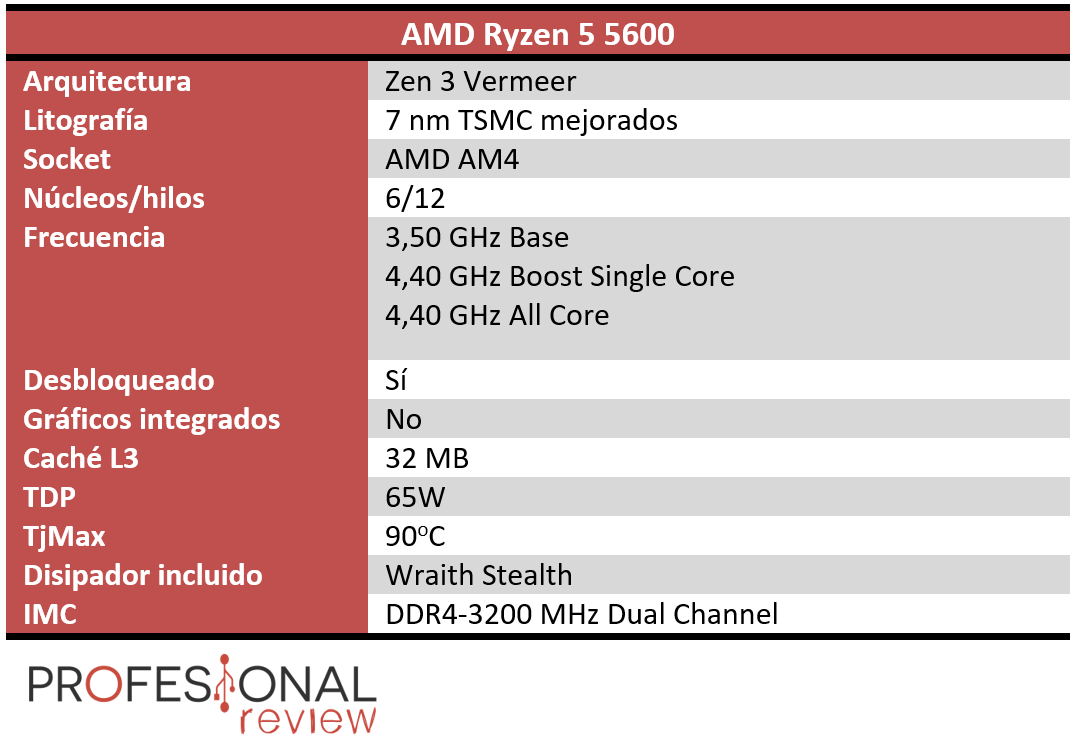
Unboxing

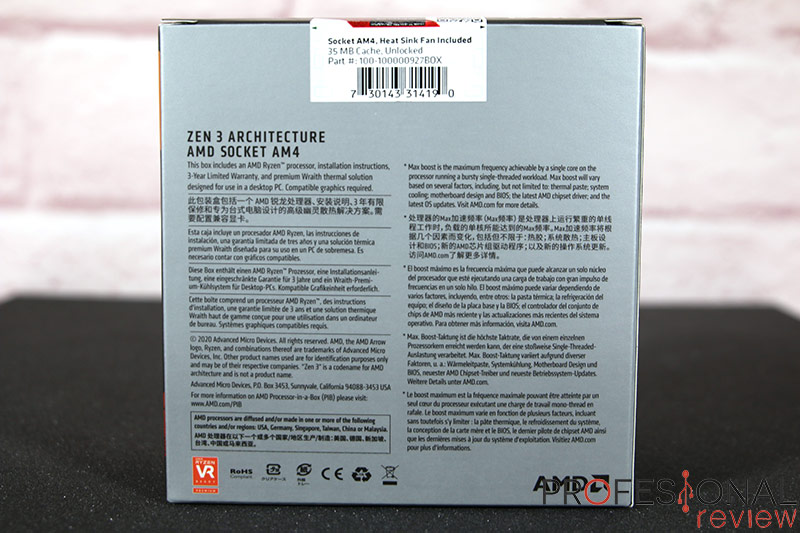
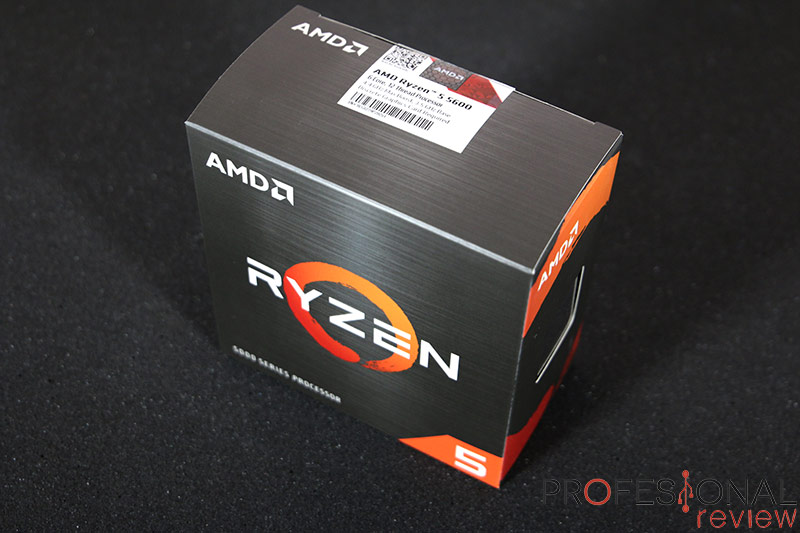
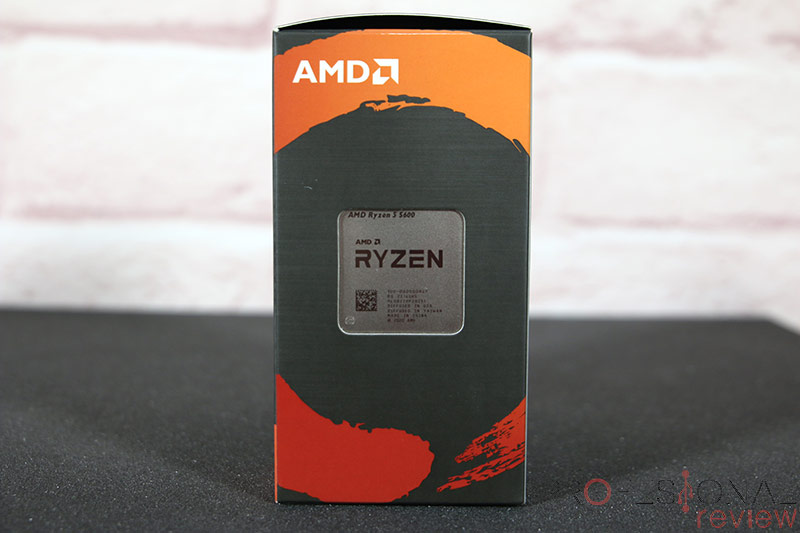
At retail, the AMD Ryzen 5 5600 will arrive just as you can see in the screenshots, with the usual flexible cardboard box and the gray and orange Ryzen decoration. On one side, the CPU is shown through an opening, protected within a plastic blister . Next to it, we have another rigid cardboard box housing the included heatsink.
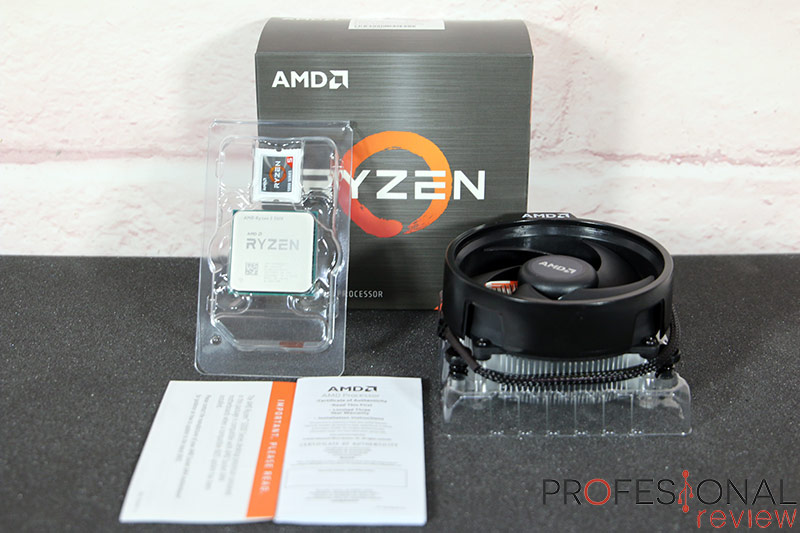
The contents of the box will be as follows:
- CPU AMD Ryzen 5 5600
- Disipador Wraith Stealth
- Documentation and warranty
Closing performance gaps in the mid-range
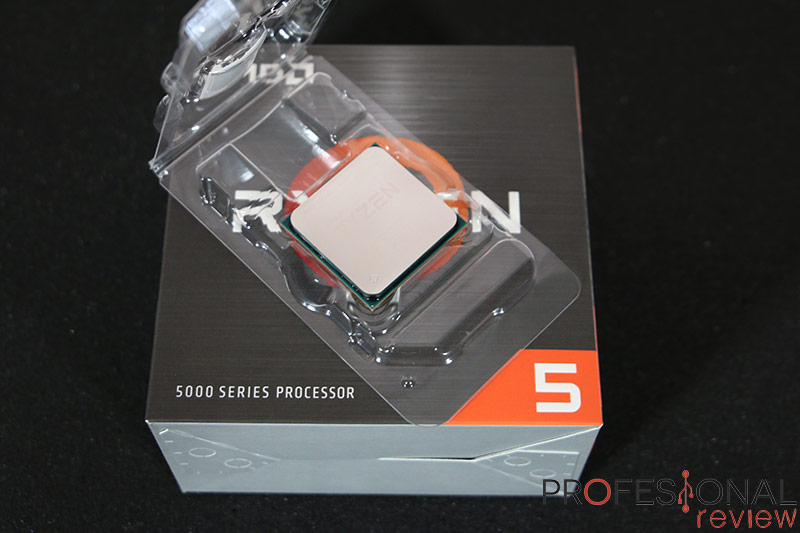
The AMD Vermeer Zen 3 architecture turns one and a half years old this May 2022, and the brand is still allocating resources to new CPUs after seeing the great performance demonstrated by the Intel Alder Lake. There wasn't much more to do at the high-end, but it was achieved with the 5800X3D which, thanks to its 3D V-Cache, has put the 12900K in a jam in gaming.
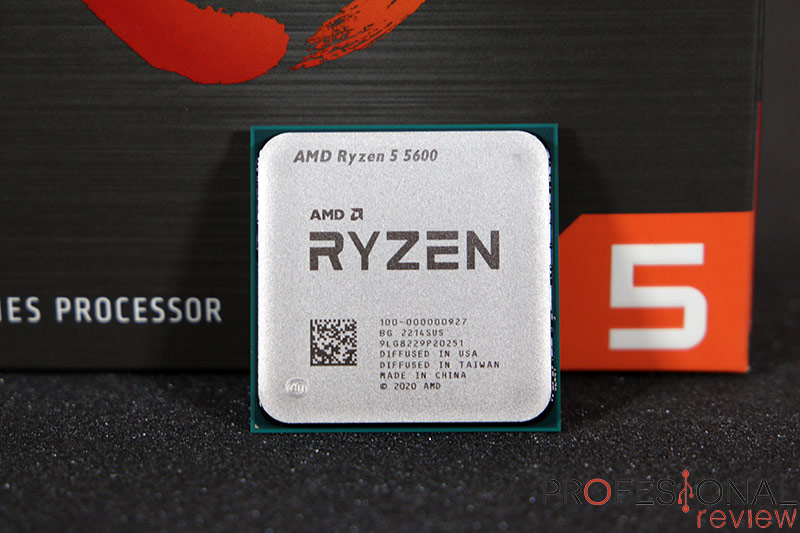
There are interesting possibilities in the mid-range, so it has focused its efforts on launching a total of three models to fill the gaps left by AMD and give Intel's i5s a run for their money. These new models are:
- AMD Ryzen 5 5500 : A 6-core, 12-thread model based on the Cezanne architecture , just like the APUs, but without an integrated GPU to focus on gaming setups. A direct rival is the 12400, which offers decent performance at a very low price.
- AMD Ryzen 5 5600 : This model is based on the Vermeer node , with the drawbacks of the single CCX versions on the Infinity Fabric bus, but showing very similar performance to the 5600X.
- AMD Ryzen 7 5700X : This other model is a 5800X cut in frequency , that is, it will have 8 cores and 16 threads based again on Vermeer
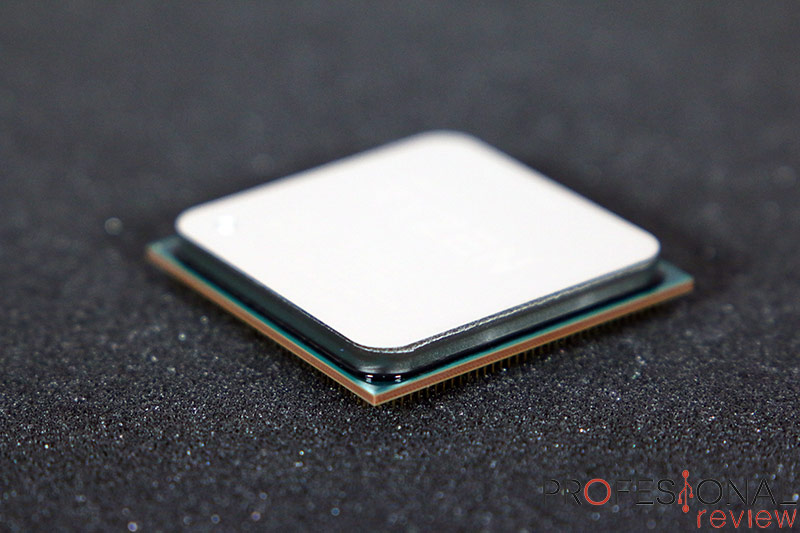
We now focus on the model we are analyzing, an AMD Ryzen 5 5600 that shows no structural differences compared to its older brother and the rest of the Zen 3 CPUs. We have an AM4 PGA type socket with 1331 gold-plated contacts on which rests the substrate containing two chiplets.
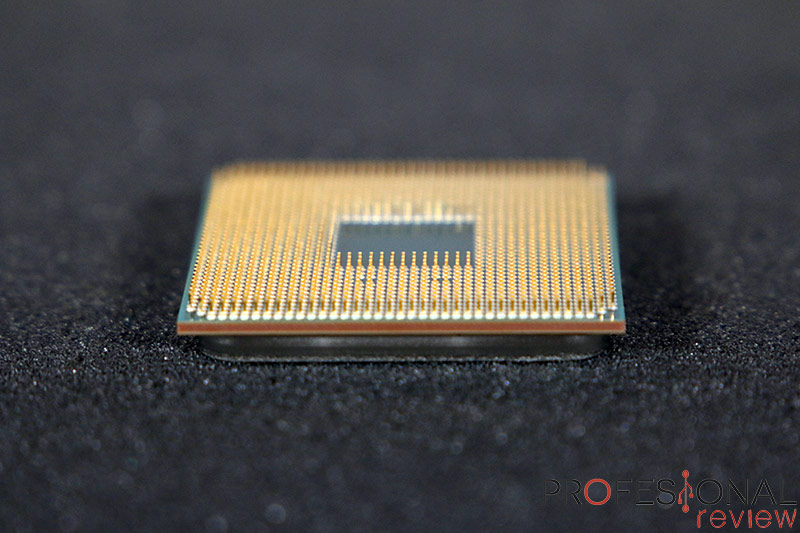
Above them, a copper and aluminum heat sink covers the components and delivers heat to the heatsink as efficiently as possible. To achieve this, this element has been soldered onto the core die, making it difficult to separate them, for example, to create a delid. This isn't necessarily necessary for this type of CPU, which generates little heat.
Heatsink included
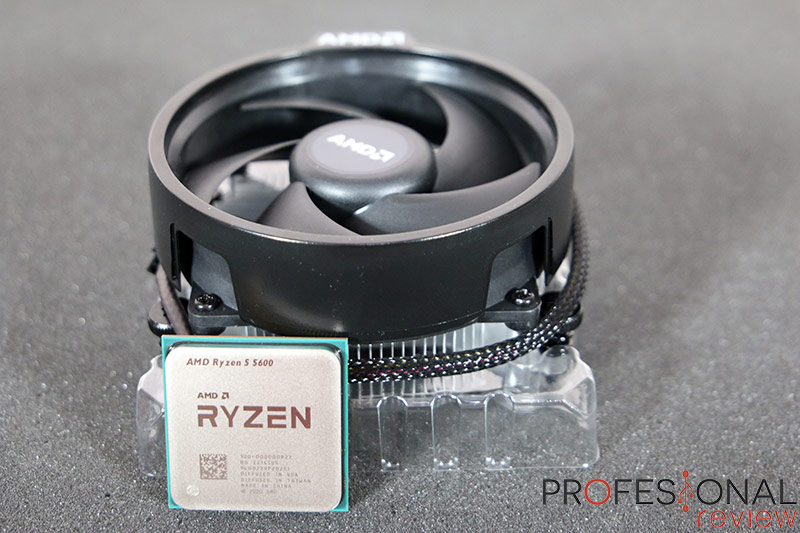
As is customary in this range of 65W TDP processors , the Wraith Stealth cooler has been included , the second highest in performance compared to the Athlon, but below the Spire and, of course, the Prism. However, it will be a suitable cooler, especially for those with small chassis, as it takes up very little space.
El disipador consiste en un bloque íntegramente de aluminio con diseño circular y provisto de aletas que parten desde el cilindro central hueco. Las medidas del bloque serán de 20 mm de grosor y 90 mm de diámetro. Medida que coincide con el diámetro del ventilador, el cual presenta un diseño axial con 5 aspas y un aro exterior para concentrar el flujo de aire hacia el bloque.
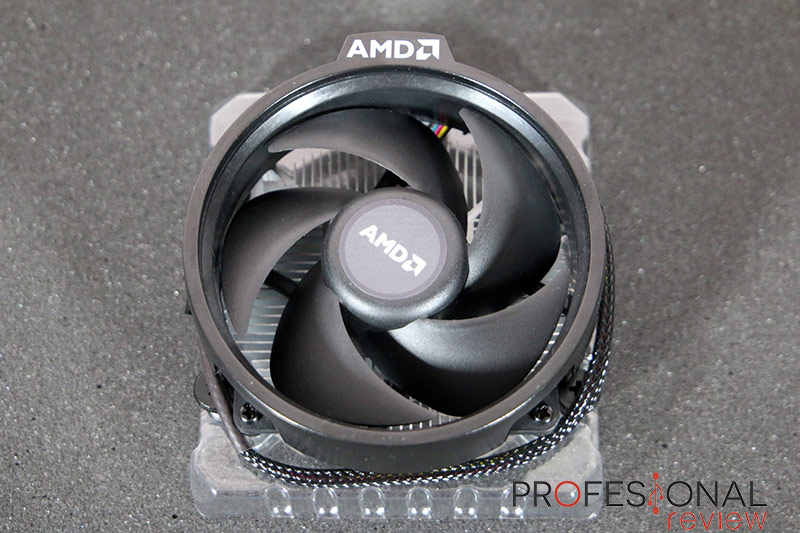
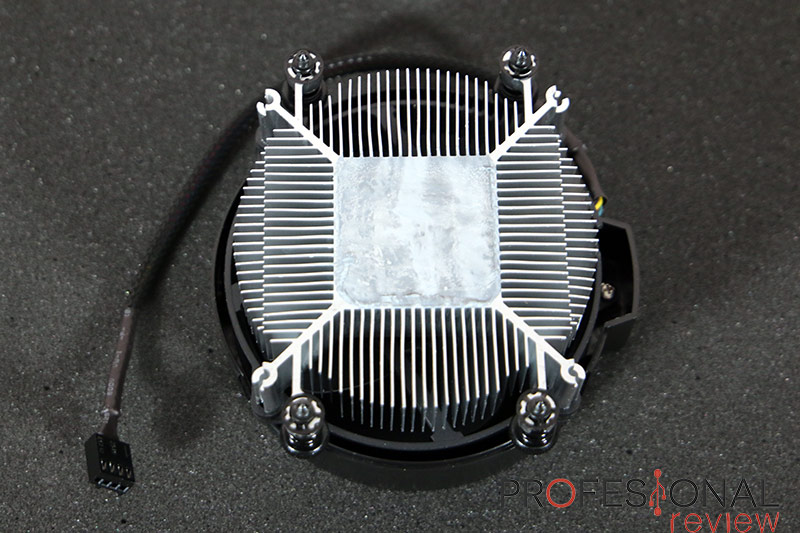

A máximo rendimiento será un poco ruidoso, y aunque es suficiente para el AMD Ryzen 5 5600 sin OC, preferiríamos un disipador custom de mayor tamaño que de más garantías en ambientes calurosos y con chasis mal refrigerados. Como venimos haciendo últimamente, colocaremos un sistema RL AIO de 240 mm para realizar las pruebas y conseguir el máximo rendimiento posible.
Arquitectura y datos técnicos del AMD Ryzen 5 5600
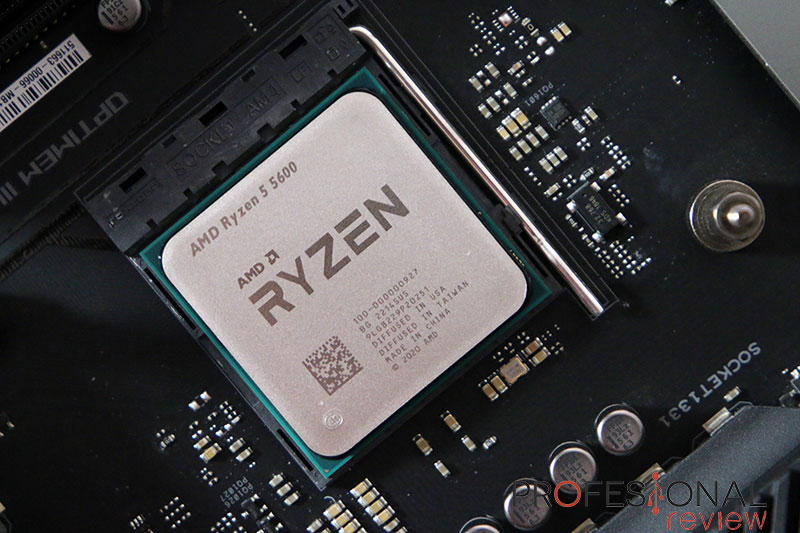
Estudiamos ahora la arquitectura utilizada para crear este AMD Ryzen 5 5600, que en definitiva será la misma que llevan los demás procesadores Ryzen 5000 destinados a gaming. Se trata de un troquel denominado Zen 3 Vermeer basado en un proceso de fabricación en 7 nm mejorados TSMC.
La arquitectura basada en chiplets nos deja en este modelo en un solo CCD, que tras Zen 2 se ha unificado internamente para también tener un CCX en lugar de dos. Dentro, encontramos un total de 6 núcleos físicos activos y 12 hilos, aunque en realidad el CCX tiene 8 núcleos. Significa por tanto que un 5700X o un 5800X estructuralmente va a ser igual a esta CPU. La frecuencia es lo único que cambia respecto al 5600X, en este caso parte de un reloj base de 3,5 GHz (3,7 GHz en el 5600X) y alcanza un boost de 4,4 GHz en todos los núcleos (4,6 GHz el 5600X).
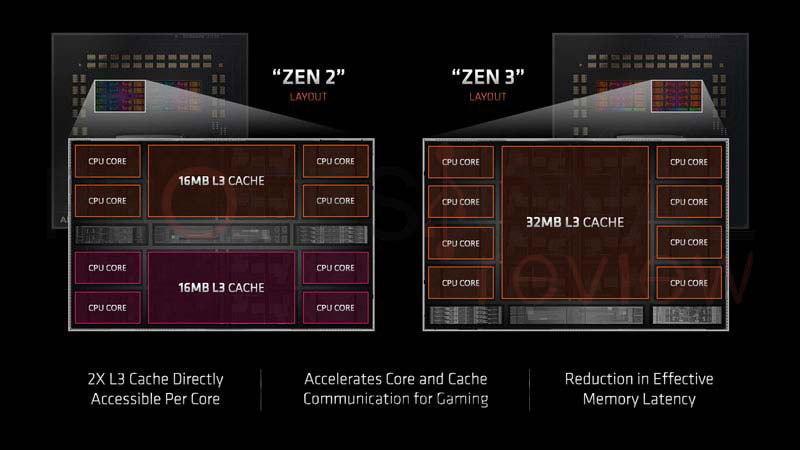
Estos 200 MHz menos posiblemente consigamos recuperarlos haciendo overclocking manual, ya que esta CPU tiene sus núcleos desbloqueados, veremos hasta dónde es capaz de llegar nuestra unidad. La configuración de memoria caché consiste en un bloque L3 de 32 MB unificado y accesible para todos los núcleos, bloques L2 con 512 KB por cada núcleo haciendo un total de 3 MB, y finalmente memoria caché L1 dividida en L1-I y L1-D con capacidad de 32 KB por cada núcleo.
Sobre el papel el rendimiento entre ambas CPU va a ser muy similar, especialmente en multi-core al solo haber 200 MHz de diferencia entre ellas. En single-core es verdad que la diferencia será un poco superior, algo obvio. El TDP con 65W se mantendrá igual, pero su TjMax pasa de 95 a 90oC, por lo que a priori es una CPU un poco menos resistente, o menos permisible con las temperaturas antes de llegar a su throttling.

El segundo chiplet presente en la CPU será el de E/S, el que contiene el controlador de memoria y de carriles PCIe conocido como north bridge. A diferencia de los núcleos, este se basa en un proceso de fabricación en 12 nm construido por Global Foundries, y cuenta con 24 carriles PCIe 4.0. De ellos, 20 están disponibles para ranuras de expansión y otros 4 para comunicación con el puente sur.
La capacidad de memoria RAM se mantienen en 128 GB compatible con Dual Channel. Ofrece soporte nativo para módulos de 3200 MHz, dando una relación 1:1:1 con Infinity Fabric, y el Hub Controller. Este modelo al igual que las otras CPU Ryzen con un solo chiplet activo (hasta 8 núcleos), tiene el bus Infinity Fabric desde el CIOD al CCD reducido a la mitad en la línea de escritura. Esto significa que hay 32 bits/ciclo para lectura en memoria RAM y solo 16 bits/ciclo en escritura, por lo que su rendimiento cae a la mitad.
Banco de pruebas y test de rendimiento
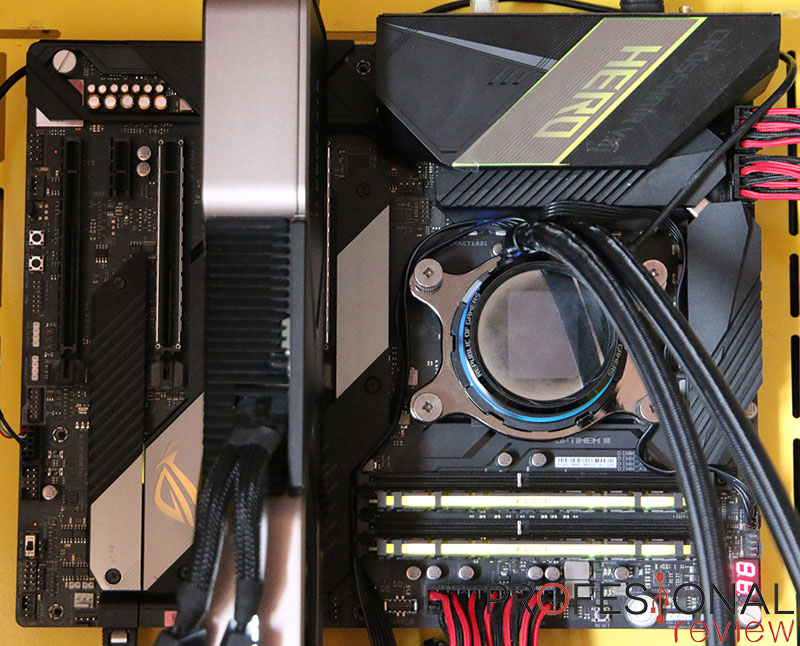
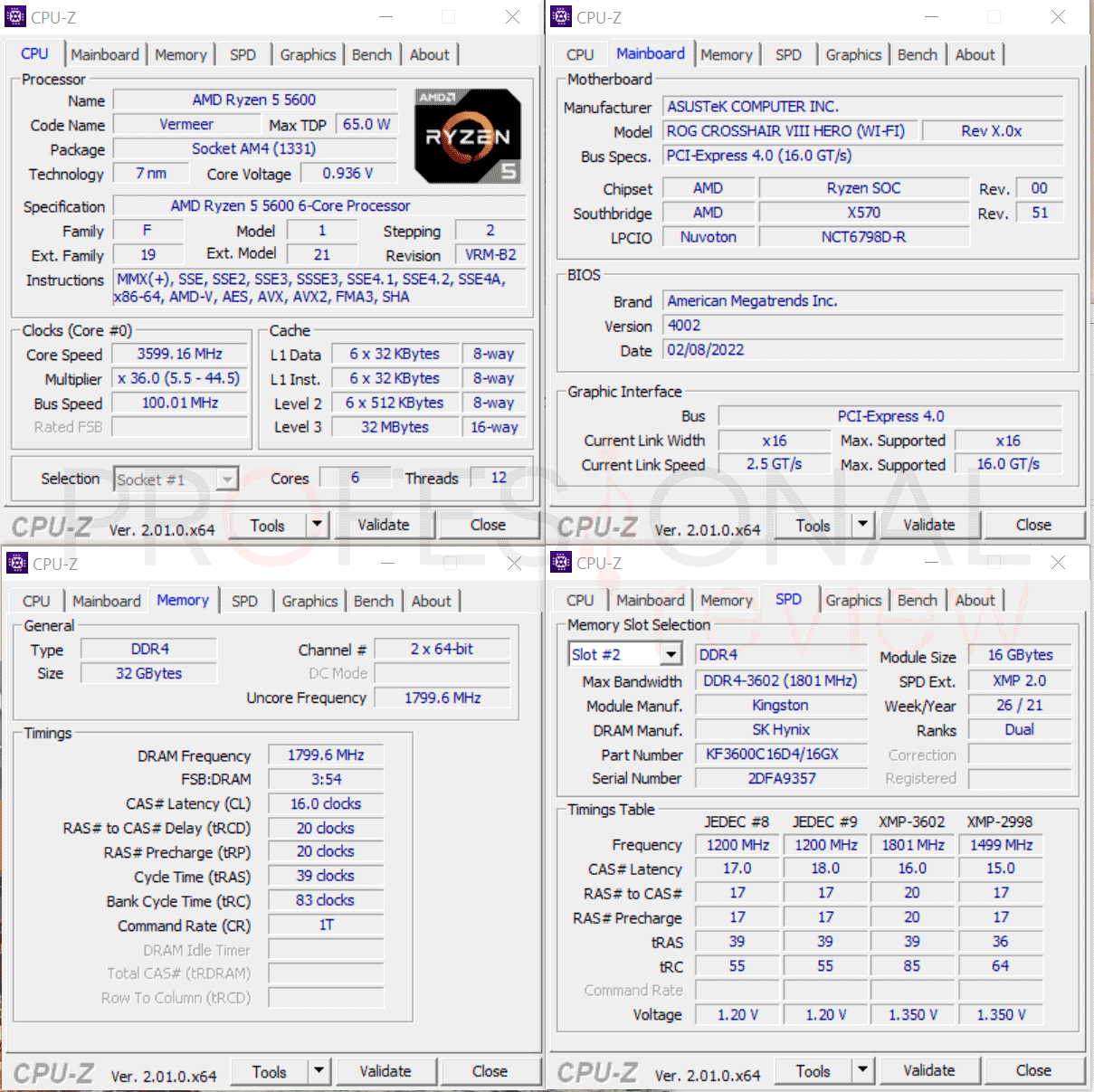
Llega el momento de traducir en números los que hasta ahora hemos escrito, así que procedemos a realizar las pruebas habituales con el AMD Ryzen 5 5600 y la siguiente configuración de hardware:
BANCO DE PRUEBAS
Procesador:
AMD Ryzen 5 5600
Placa Base:
Asus ROG Crosshair VIII Hero
Memoria RAM:
32 GB Kingston Renegade DDR4 3600MHz
Disipador
Asus ROG Ryuo 240
Disco Duro
Samsung 860 QVO
Tarjeta Gráfica
Nvidia RTX 3080 Ti
Fuente de Alimentación
Corsair RM1000
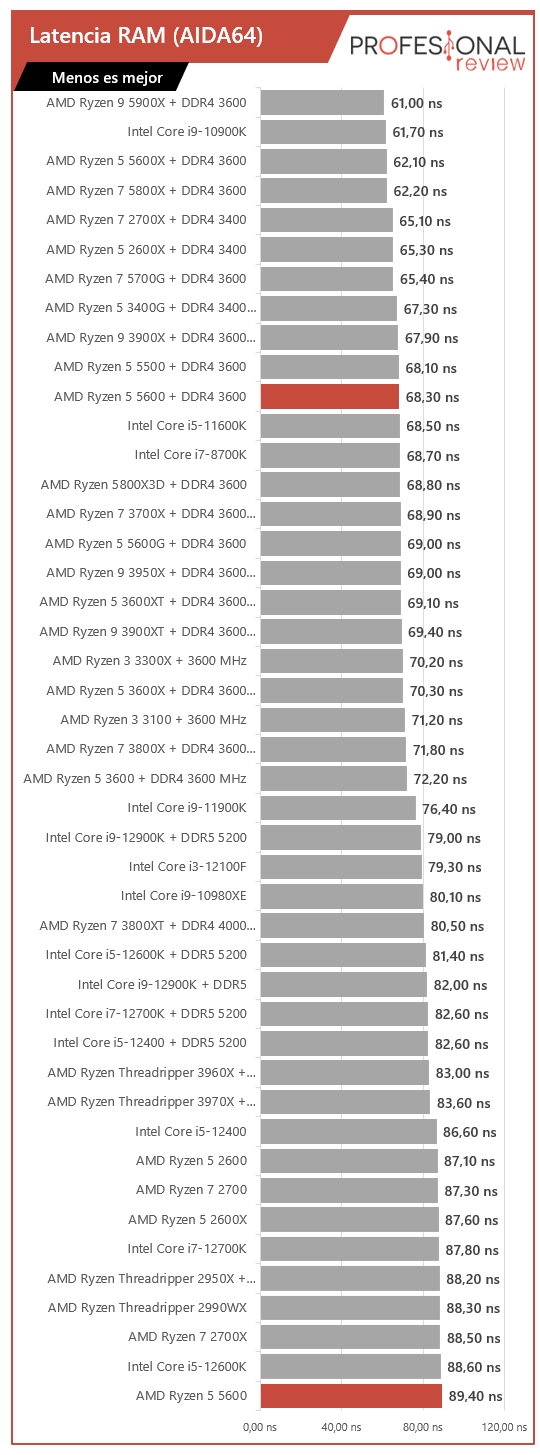
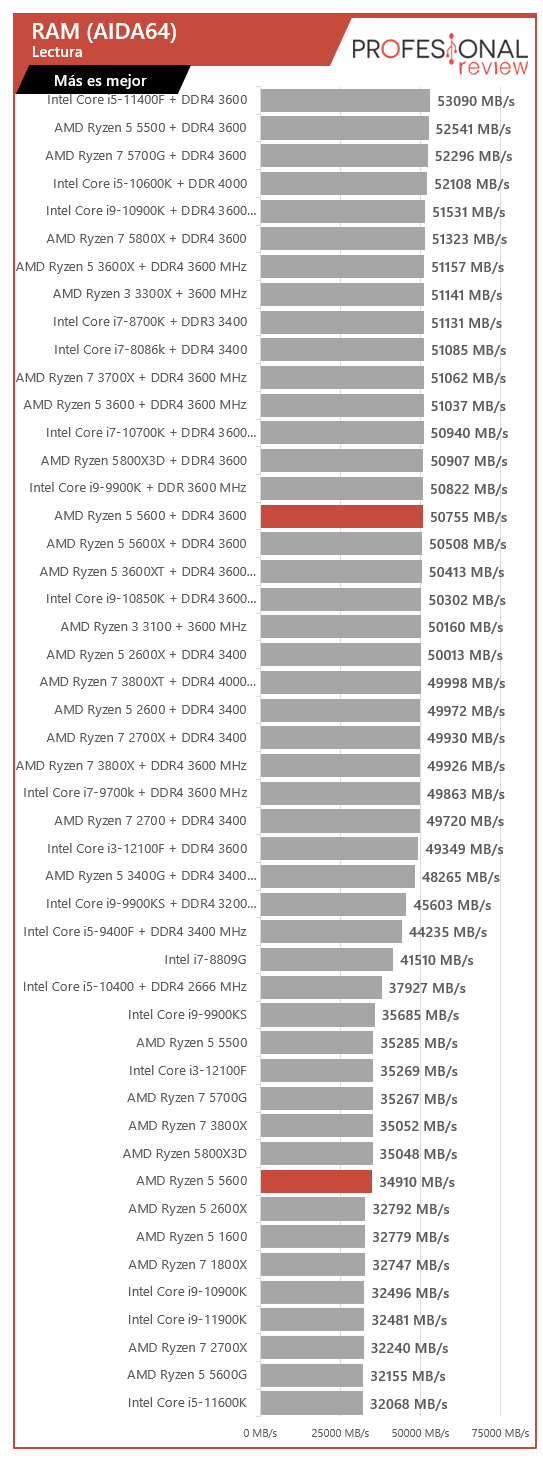
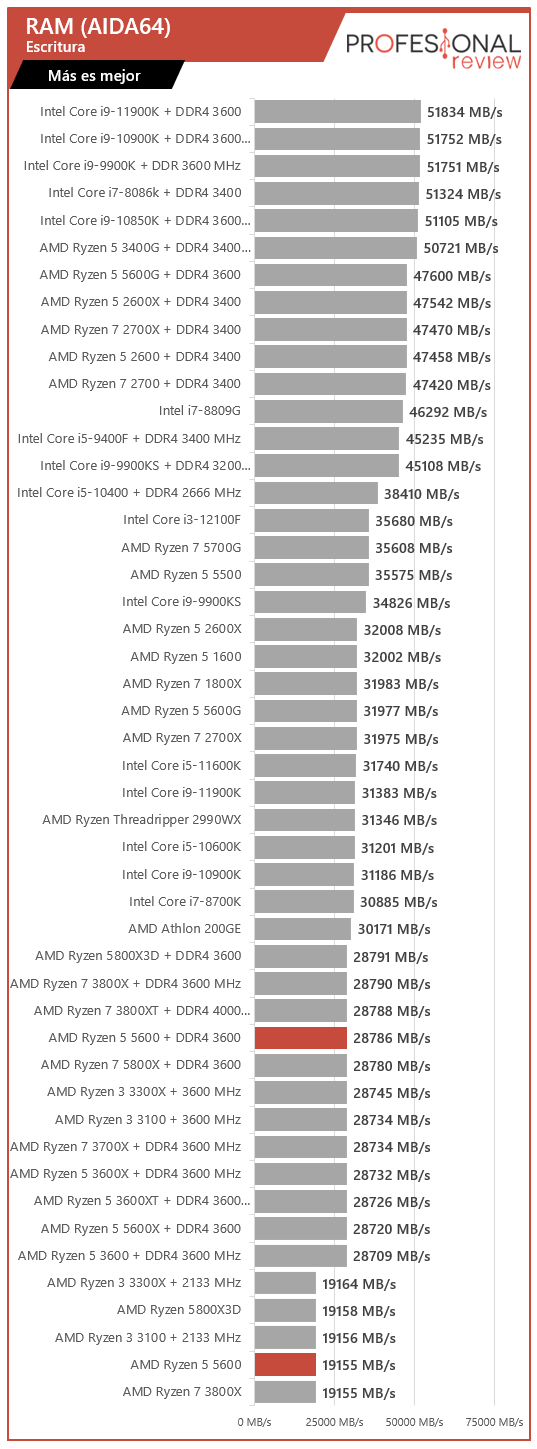

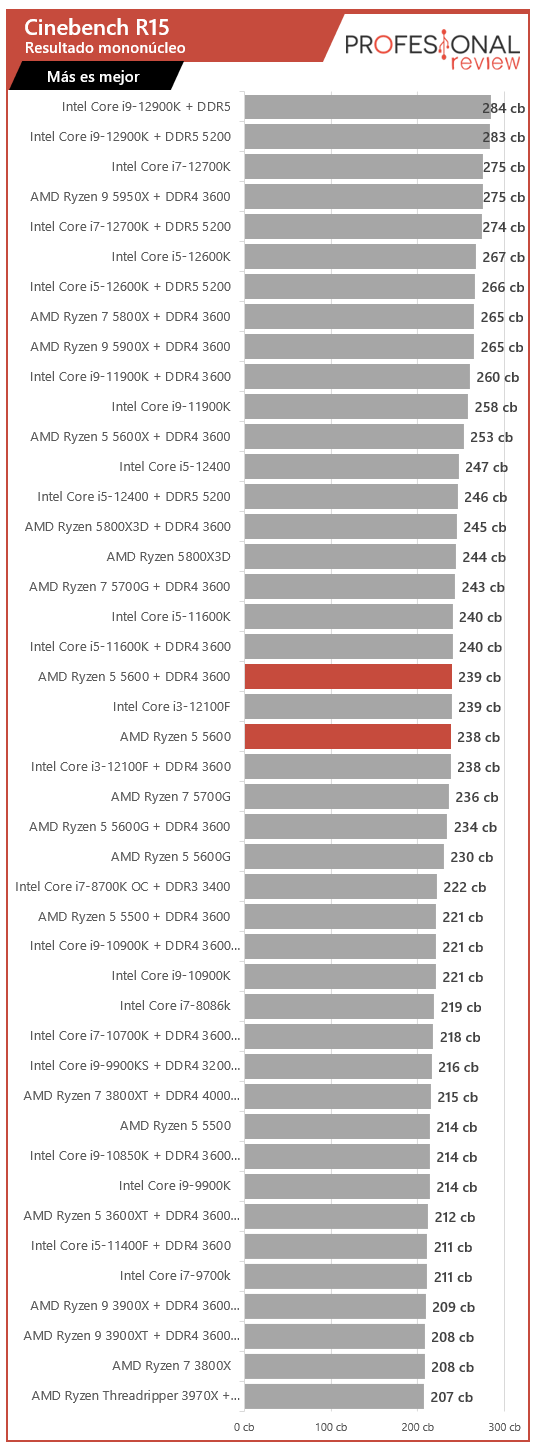
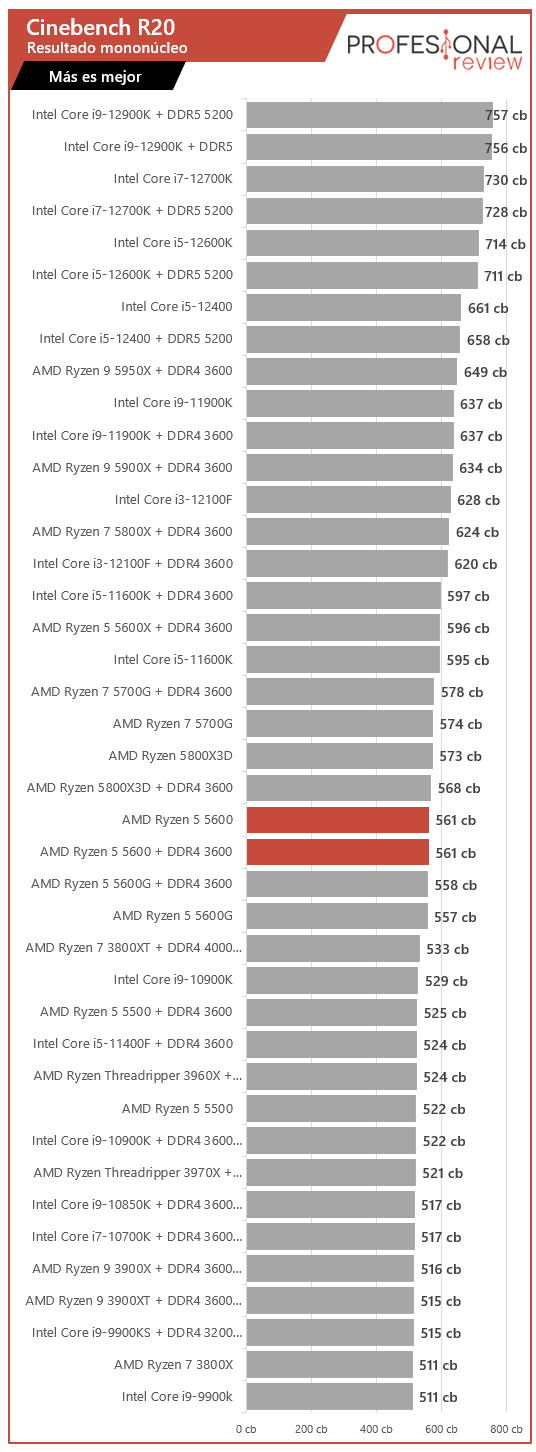

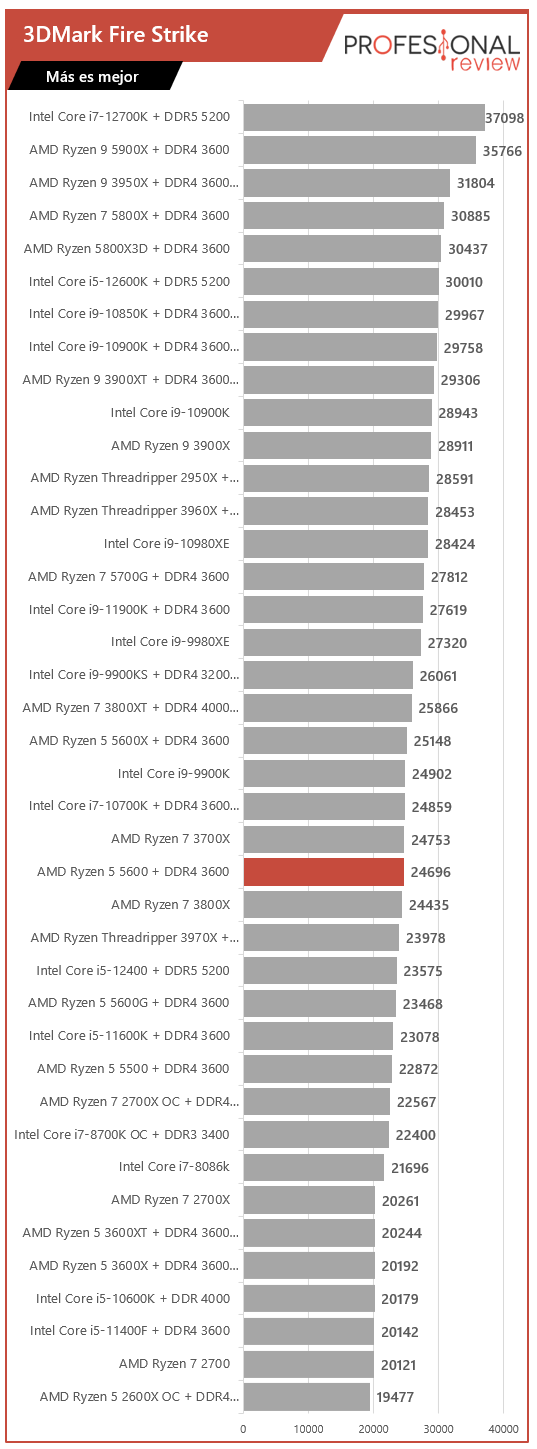
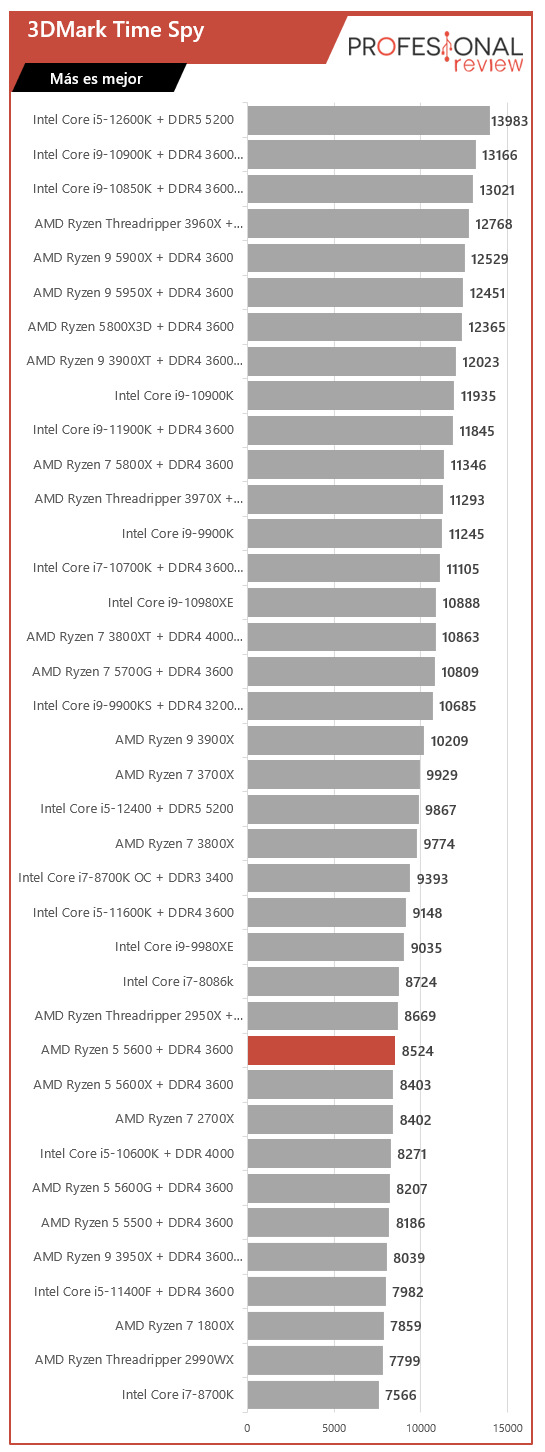

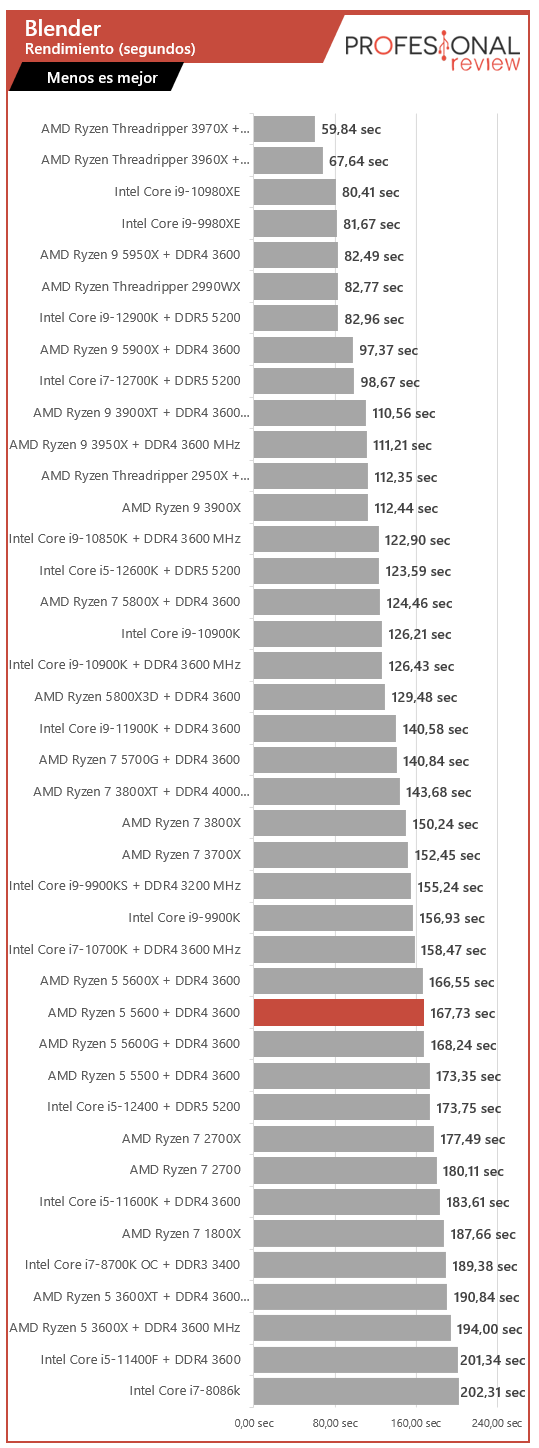
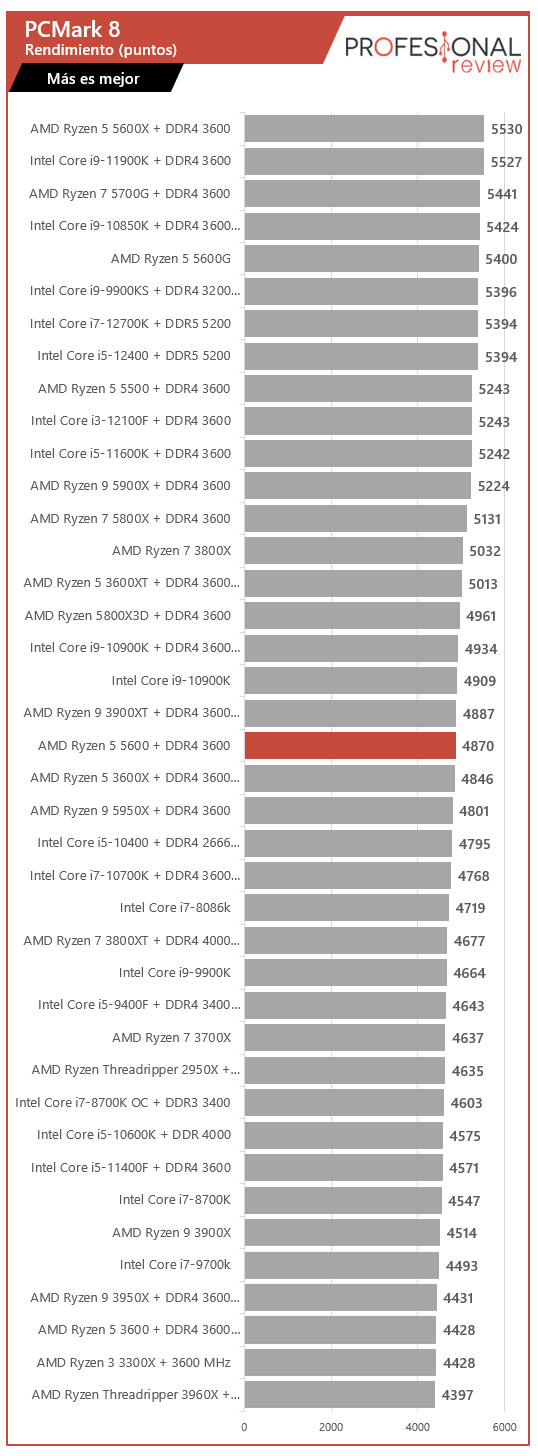
El rendimiento en memoria RAM refleja el hecho de tener un bus de lectura de 16 bits en lugar de 32 bits, pero más allá de eso las cifras son nominales. Tal y como era previsible, las cifras en Cinebench muestra que este 5600 está prácticamente pegado al 5600X en multi-core y un poquito más lejos en single-core. Sin embargo no es capaz de superar en rendimiento a las CPU de 6 núcleos Intel Alder Lake, ni tan siquiera al i5-12400, así que en rendimiento puro, la marca azul gana.
El rendimiento en juegos lo mantiene muy cerca de su hermano, y consigue superar al i5-12400 en pruebas con DirectX 11, veremos sí también pasa igual en gaming. Otra prueba relevante como es Blender confirma una vez más su inferioridad con el 12400, y paridad con el 5600X.
Pruebas en juegos
Es el turno de evaluar el rendimiento gaming en las principales resoluciones Full HD, 2K y 4K con los siguientes títulos y configuraciones:
- Shadow of the Tomb Raider, Alto, TAA, DirectX 12
- Far Cry 5, Alto, TAA, DirectX 12
- DOOM Eternal, Ultra, Vulkan
- Final Fantasy XV, standard, TAA, DirectX 11
- Deus EX Mankind Divided, Alto, DirectX 11
- Metro Exodus, Alto, DirectX 12
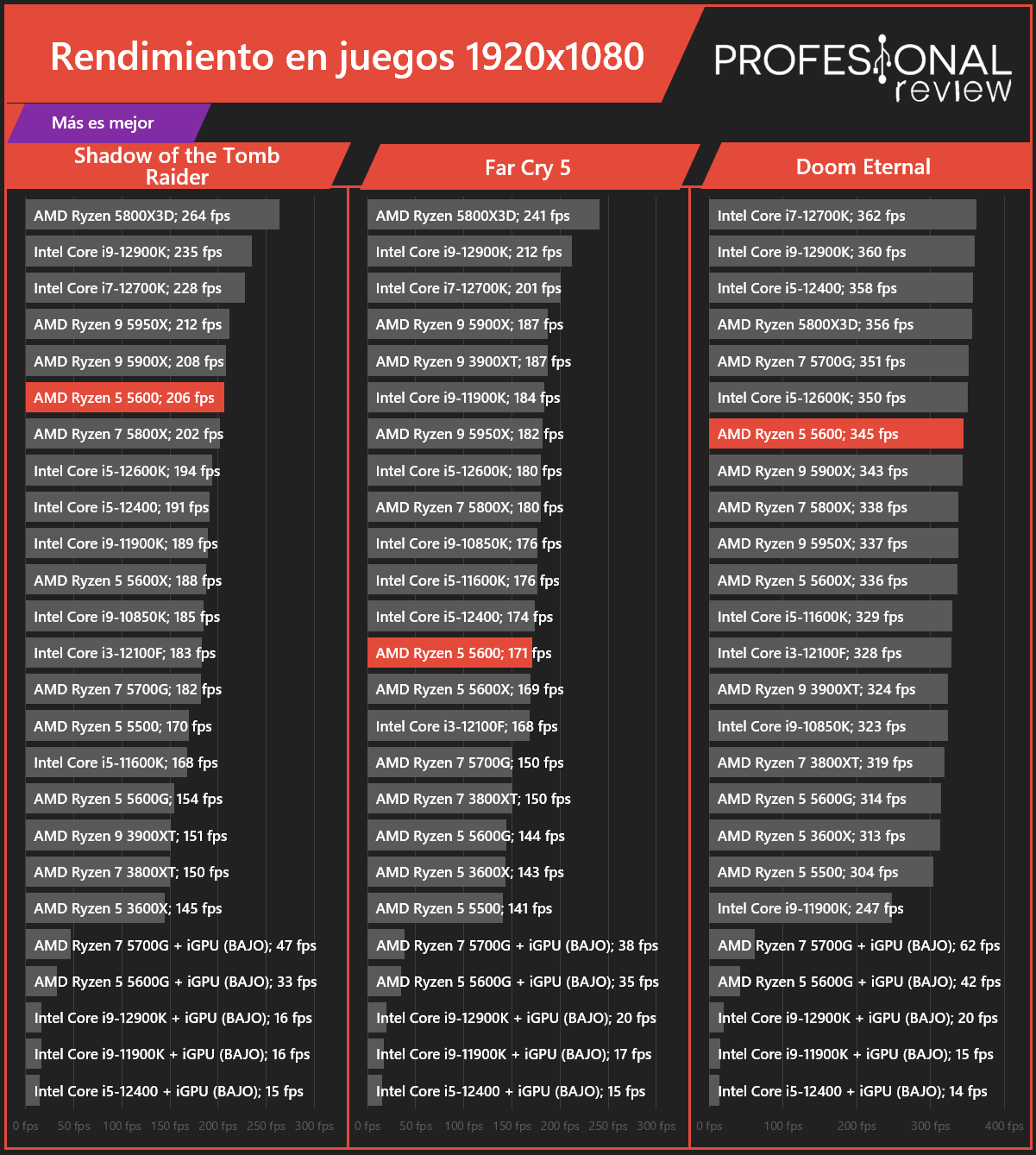
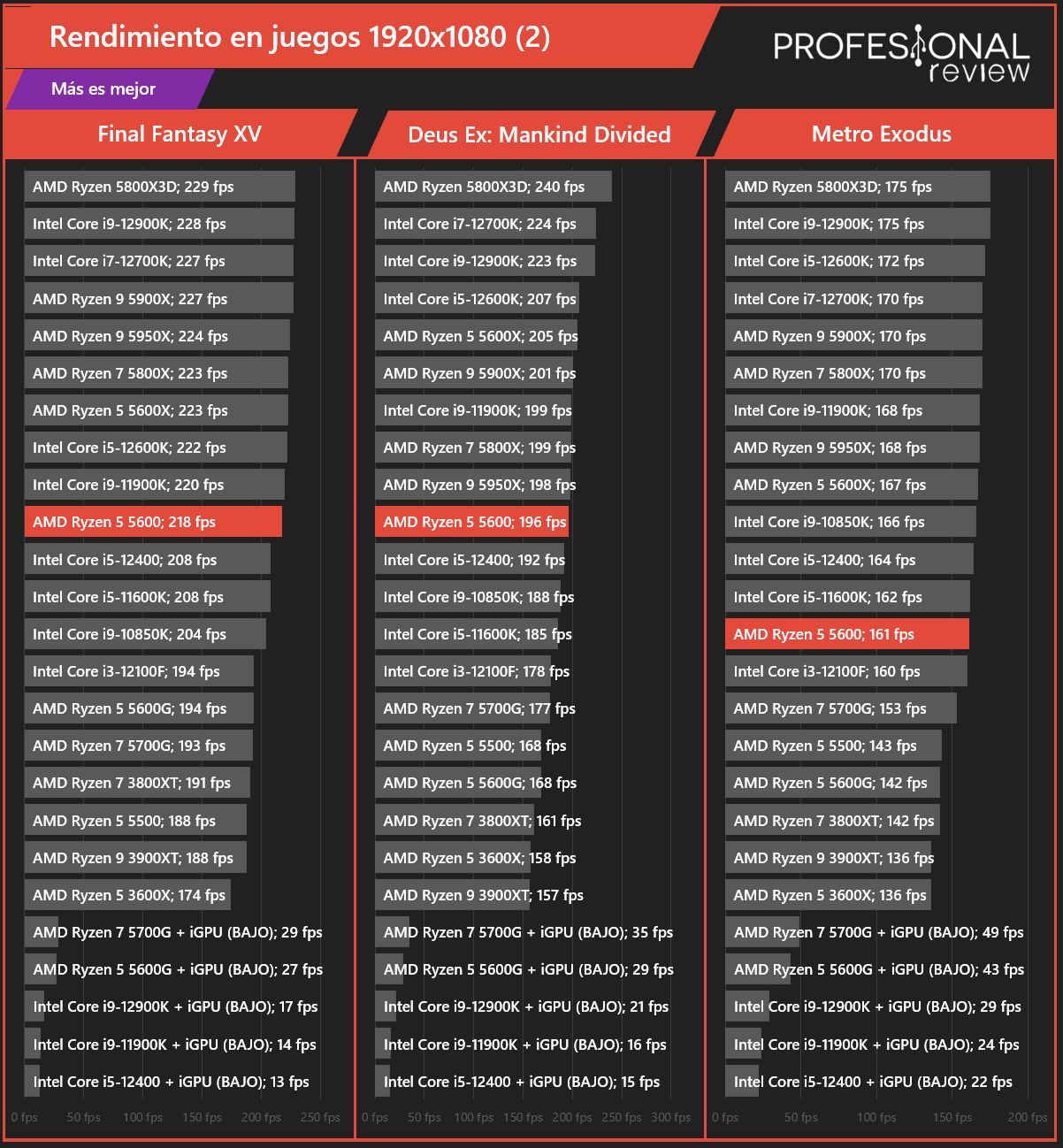

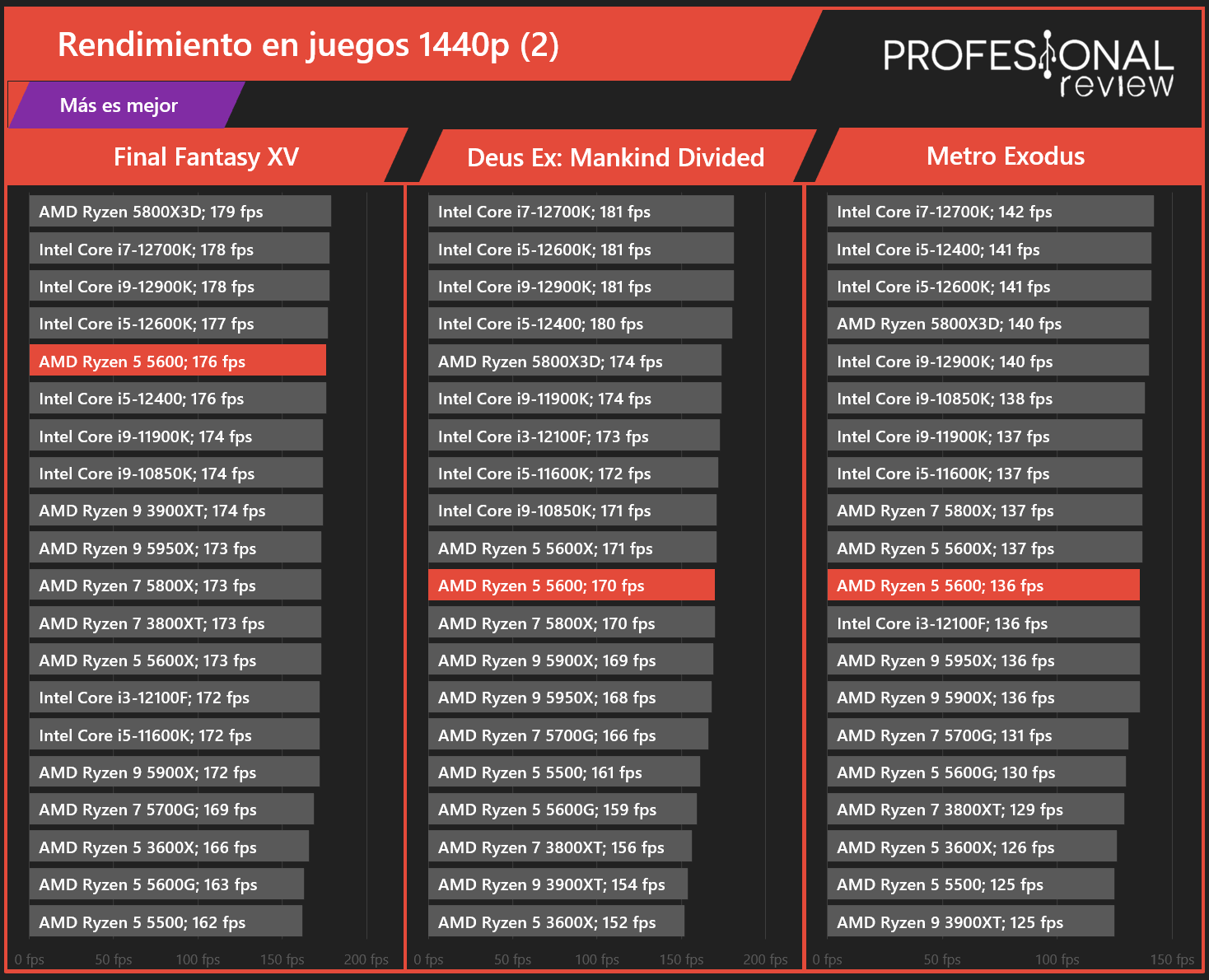
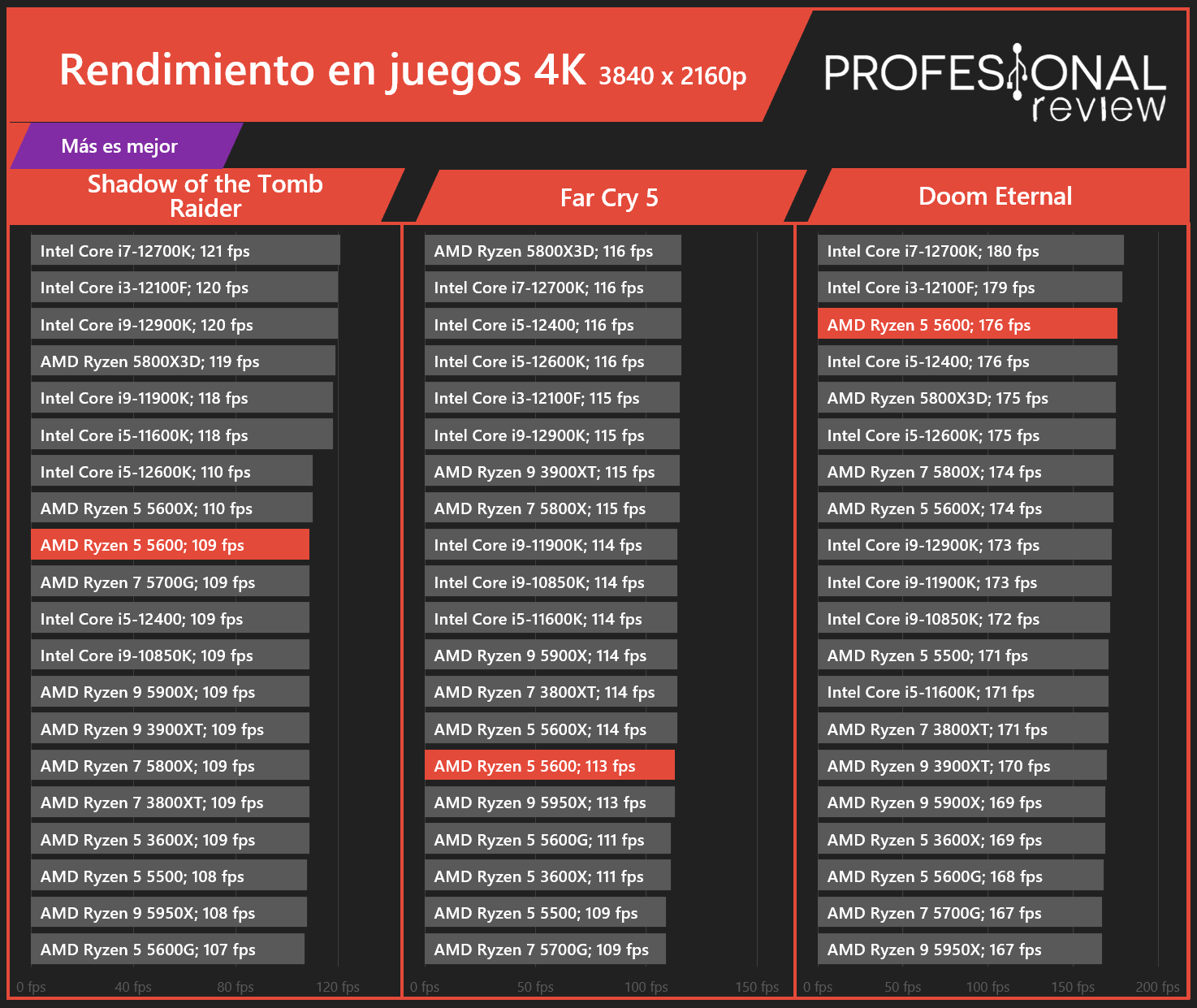

¿Rinde bien esa CPU en gaming? Pues no lo hace nada mal, y en Full HD consigue sobrepasar al 12400 de Intel en algunos títulos y quedarse muy cerca en otros. Es capaz de mantener la punga en 2K, con la CPU de Intel e igualar nuevamente el 5600X, para finalmente ver que en 4K los resultados serán prácticamente iguales que el resto de CPU al tener casi todo el peso la GPU.
Overclocking
La siguiente prueba será efectuar un proceso de overclocking para ver hasta dónde puede llegar este AMD Ryzen 5 5600 y si es capaz de igualar o superar a su hermano superior. Llevaremos a cabo el procedimiento directamente en la BIOS de la placa Asus.
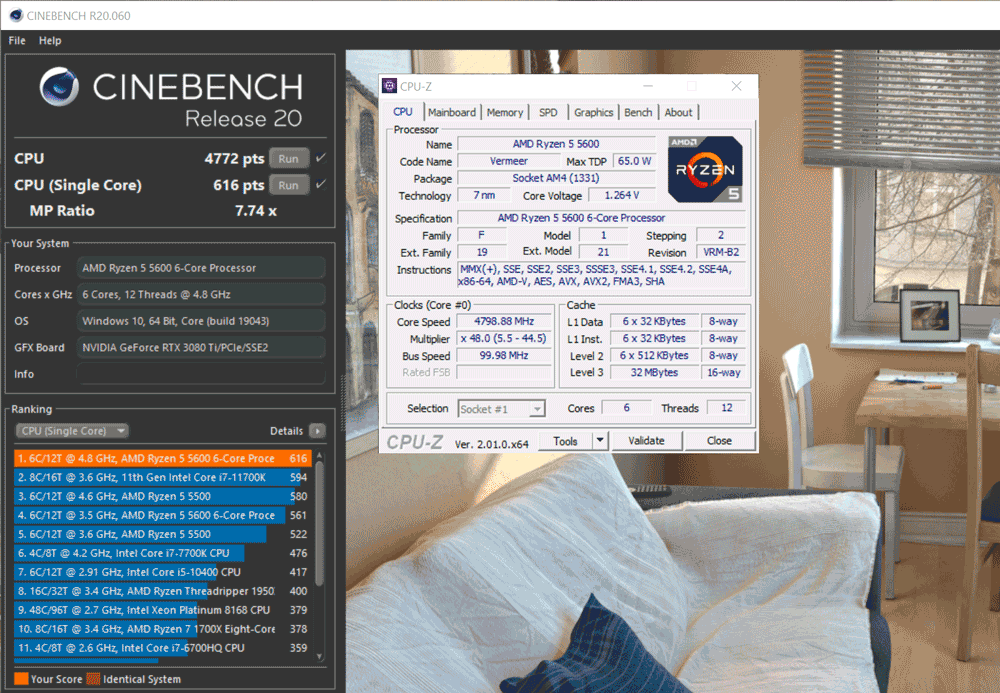
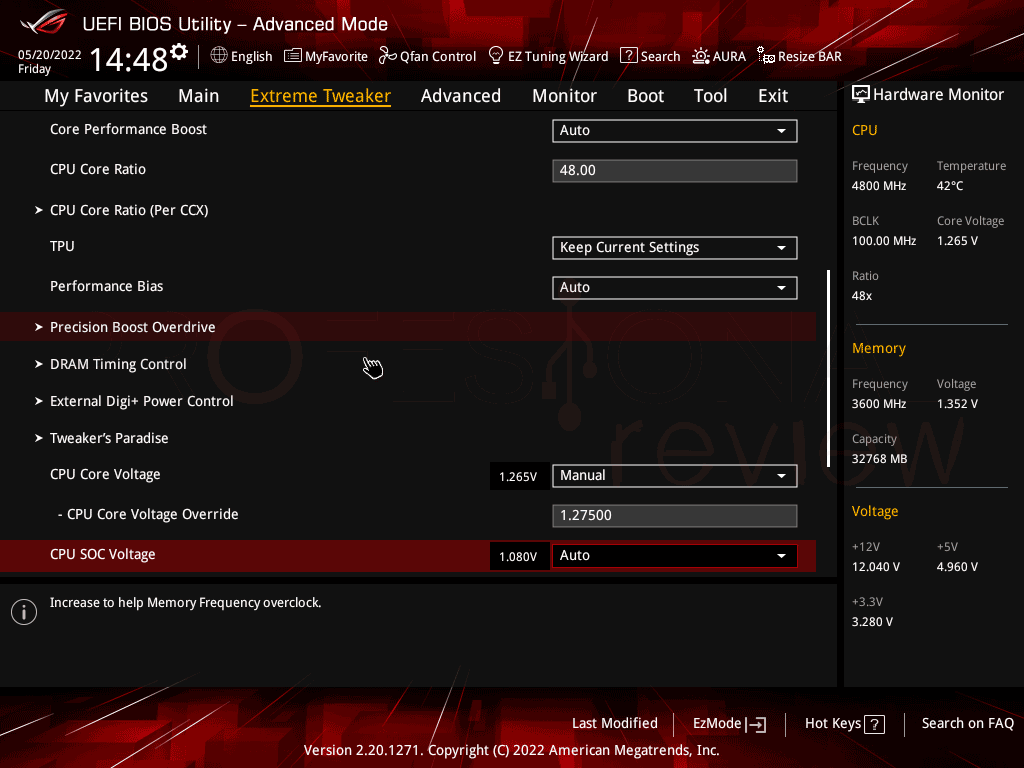
Hemos conseguido fijar una frecuencia máxima de 4,8 GHz en todos lo núcleos estables a 1,275V con un LLC nivel 2 en la BIOS Asus. Son cifras similares al 5600X, mejorando un poco los voltajes y consiguiendo estabilidad bajo estrés continuado. Esto nos ha servido para superar el modelo directamente superior, demostrando ser una CPU que con un aumento de 200 MHz igualará al 5600X y no tendremos problemas de estabilidad en gaming..
| Modo | Stock | OC | Incremento |
| Cinebench R20 Multi | 4338 | 4772 | 10,0% |
| Cinebench R20 Single | 561 | 616 | 9,8% |
| Tomb Raider | Stock | OC | Incremento |
| 1080p | 206 FPS | 213 FPS | 3,4% |
| 2K | 177 FPS | 180 FPS | 1,7% |
| 4K | 109 FPS | 110 FPS | 1% |
Los resultados son bastante relevantes para tratarse de un aumento de frecuencia de 400 MHz, y vemos como mejora hasta un 10% en multi-core o más de un 3% en gaming a resolución 1080p. Si a esto le añadimos la función Resizable Bar de las GPU actuales y el consiguiente overclocking a la GPU podríamos conseguir aumentos superiores al 10% en juegos.
Consumo y temperatura
Finally, we stress- tested this AMD Ryzen 5 5600X with Prime95 and the 240mm liquid cooling system. We measured individual CPU temperatures and power consumption with HWiNFO , and the entire bench's power consumption with a wattmeter .
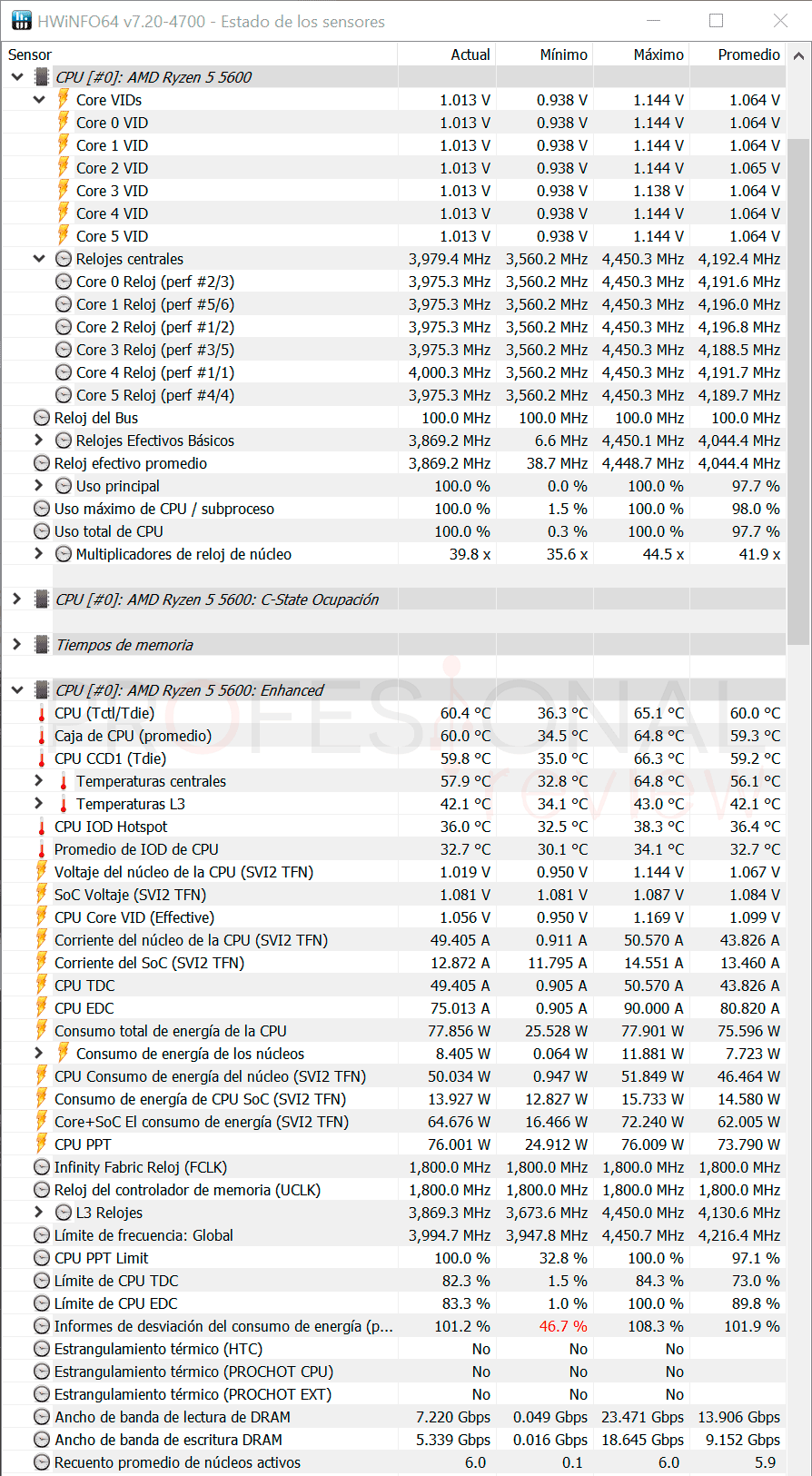
In the stock configuration of this motherboard the CPU has been kept at a relatively high temperature and consumption in total idle , although base stress has remained very close to 5500 and below Intel's 12400, with the CPU only consuming 26W at idle and 76W on average under stress with peaks of 78W. With the increase in voltage and frequency the individual consumption figures become 38W at idle, 90W under stress and 106W peak.
Temperatures are quite good throughout, and this 240mm system will be more than enough for this CPU. However, under overclocking, there is a point, after about 12 continuous minutes of stress, where temperatures soar to their maximum TjMax of 90 ° C . However, this only occurs when the CPU is running at 100% nonstop, a scenario that only occurs in specific tests.
Final words and conclusion about the AMD Ryzen 5 5600
We're finishing up this review, and the first logical question is: Does this Ryzen 5600 really make sense compared to the 5600X? Well, certainly not, since the results in both games and benchmarks are practically identical between the two models . The only difference between them is their stock frequency, which is 200 MHz lower for the non-X model.
AUTHOR: JOSÉ ANTONIO CASTILLO
SOURCE: PROFESSIONAL REVIEW
